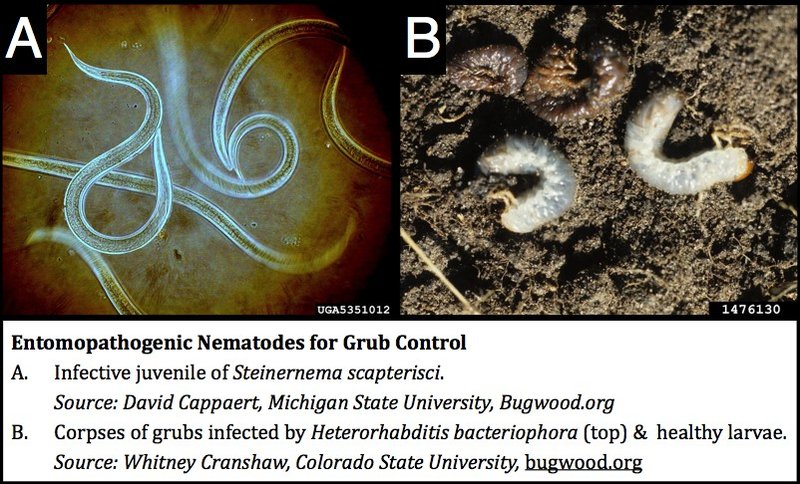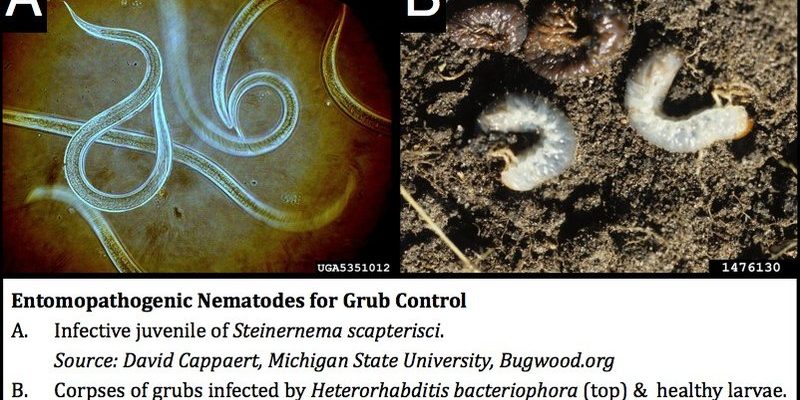
Think of nematodes as tiny, microscopic soldiers in your garden army—here to help you fight those pesky grub worms without the need for harsh chemicals. These beneficial nematodes are a type of roundworm that specifically targets and kills grubs and other garden pests. So, how do these little warriors work? Let’s dive in and explore how biological controls like nematodes can help keep your garden healthy and thriving.
What Are Nematodes?
To understand nematodes, let’s start with the basics. Nematodes are microscopic, cylindrical organisms found in soil, water, and even inside some plants. While there are thousands of species, only a few types are useful for pest control. These beneficial nematodes are natural predators that seek out harmful insects, including grub worms.
You might be wondering how something so tiny can make a difference in your garden. Well, here’s the thing: a single nematode can infect and kill multiple grubs at once. When a nematode finds a grub, it enters the grub’s body through natural openings. Once inside, it releases bacteria that help break down the grub’s tissues, ultimately leading to its demise. This process not only eliminates the grubs but also enriches the soil by adding organic matter as the grub decomposes.
So, why should you consider using nematodes for grub control? For starters, they’re safe for plants, pets, and humans. Unlike chemical pesticides, nematodes don’t leave harmful residues and won’t disrupt your garden ecosystem. They work silently and efficiently, helping maintain a healthy balance in your lawn and garden.
How Nematodes Combat Grub Worms
When it comes to grub worms, understanding their life cycle is crucial to grasping how nematodes can help. Grubs are the larval stage of beetles and spend most of their lives underground, munching on roots. They thrive in warm, moist conditions, making them a common problem during the summer months.
Here’s where nematodes come in. You can apply them to your soil, where they will actively seek out grubs. But it’s essential to time your application correctly. The best time to introduce nematodes is during the grubs’ active feeding stage, usually in late summer or early fall. This ensures that the nematodes have plenty of grubs to target, maximizing their effectiveness.
Once you apply nematodes, they start their hunt. They swim through the soil in search of grub worms, entering their bodies and initiating the kill process. It might sound gruesome, but this natural predation is entirely part of the ecological balance in your garden. After a few weeks, you should start to see improvements in your lawn as the grub population decreases.
Choosing the Right Type of Nematodes
When selecting nematodes for controlling grub worms, you’ll find several types available in garden centers or online. The most commonly used species are **Heterorhabditis bacteriophora** and **Steinernema carpocapsae**. Each type has its preferences and conditions for effectiveness, so choosing the right one is crucial.
**Heterorhabditis bacteriophora** are particularly good for targeting white grubs. They thrive in moist soil and prefer warmer temperatures, making them ideal for summer applications. On the other hand, **Steinernema carpocapsae** are more versatile and can handle a wider range of pests, including those in cooler temperatures.
Before you make a purchase, check the label for specific instructions and ensure that the nematodes are alive and healthy. You want to invest in a product that guarantees effectiveness, as this will make all the difference in your garden.
How to Apply Nematodes in Your Garden
Applying nematodes isn’t overly complicated, but it does require some attention to detail. Here’s a step-by-step guide to help you get started:
- Choose the Right Time: Late summer or early fall is typically the best window for application, especially when grubs are active.
- Prepare Your Soil: Water your lawn or garden thoroughly a day before applying nematodes. This helps create a moist environment that’s perfect for their activity.
- Mix and Apply: Following the package instructions, mix the nematodes with water. Use a garden sprayer or watering can to apply the mixture evenly across the infested areas.
- Water Again: After applying, give your garden another light watering to help the nematodes settle into the soil.
Remember to avoid applying nematodes during very hot or dry weather, as they require moisture to thrive. With proper application, you’ll soon notice your grub problem decreasing—along with the stress of worrying about your lawn.
Benefits of Using Nematodes
Nematodes offer a variety of advantages over traditional chemical pest control methods. Firstly, they are an eco-friendly option, helping you maintain a healthy garden without introducing harmful chemicals. This not only benefits your plants but also the local ecosystem, which includes beneficial insects and soil microorganisms.
Another great benefit is the long-lasting effectiveness of nematodes. Once applied, they can continue to reproduce in the soil, offering ongoing control as new grubs hatch and try to invade your lawn. This means that a single application could give you relief for an entire season, saving you time and effort.
Finally, using nematodes can be a cheaper alternative in the long run. Although the upfront cost may seem higher than chemical pesticides, the benefits of fewer applications and a healthier garden can save you money over time.
Potential Limitations and Considerations
While nematodes are a fantastic biological control method, there are a few things to keep in mind. For one, their effectiveness can be influenced by soil conditions. If your soil is too dry or compacted, nematodes may struggle to move and find grubs. That’s why hydration and soil health are crucial for success.
Additionally, nematodes can be sensitive to temperature changes. If you’re applying them when it’s too hot or too cold, their survival rates may plummet. To improve their chances, always follow the recommended temperature ranges provided on the product label.
Finally, keep in mind that nematodes can take some time to start showing results. Unlike chemical pesticides that act quickly, nematodes require patience as they seek out and eliminate grubs. If you’re willing to wait for nature to take its course, you’ll be rewarded with a healthier, more resilient lawn.
In the world of pest control, using biological methods like nematodes for grub worm management is a smart choice. Not only are they a natural and environmentally friendly option, but they also provide effective, long-lasting results. By understanding how they work and how to apply them properly, you can restore your lawn and garden to its former glory without the worry of harmful chemicals.
So, next time you find yourself battling grub worms, remember that you have tiny heroes at your disposal. With a little patience and care, you’ll be well on your way to a lush and vibrant garden. Happy gardening!

